|
Santa Barbara
Via Mortara and Corso della Giovecca |
|
Santa Chiara delle Cappuccine
Corso della Giovecca |
|
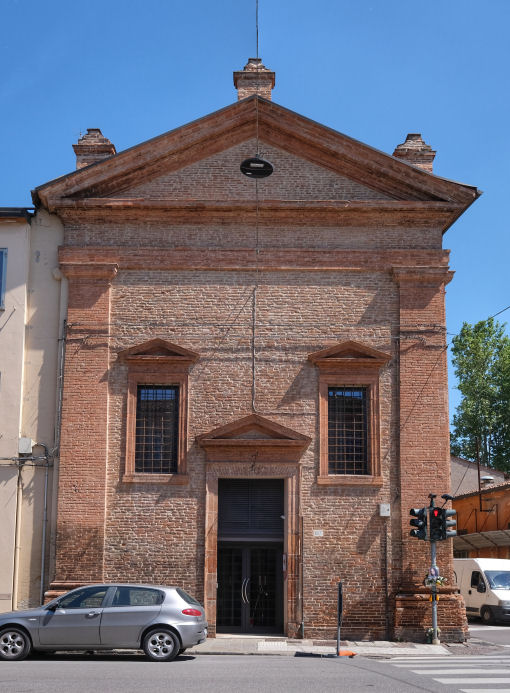
History
A school for girls, with an attached
oratory, was built in 1572, on
land opposite the monastery of
San Bernardino purchased by
Barbara of Austria, the wife of Alfonso II d'Este for this purpose.
It was then rebuilt and enlarged in 1588 by Aleotti, with the church
enlarged in 1611 and then consecrated by Bishop Fontana. With the
Napoleonic suppression the women sheltered here transferred to the
monastery of San Guglielmo.
From 1808 to 1815 the complex was returned to its former use, but the church was deconsecrated in 1950 and the
school buildings transferred to local government use. Now converted
to
holiday apartments.
The art from the complex was moved to the archives of Palazzo Schifanoia.
Lost art
A
painting of Saint Barbara and a Choir of Virgin Martyrs by
Giuseppe Mazzuoli is mentioned in an article in The Athenaeum magazine
in 1846.
The Virgin of the Rosary by Francesco Ferrari from c.1700, when the prior of the
conservatory, Domenico Gatti, built the chapel dedicated to Saint
Dominic and to the Virgin.
Opening times
Now holiday apartments
|
|
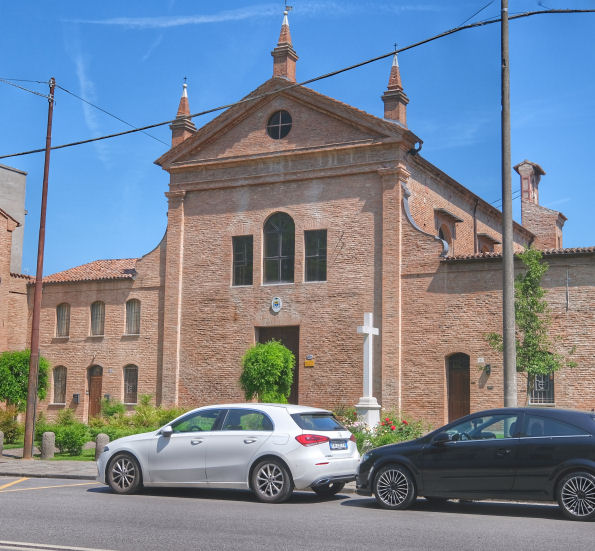
History
Building began in 1641 when Marzio
Ginetti, the cardinal legate, laid the first stone, and was finished
in 1646.
The monastery was suppressed by
Napoleon and in 1810 the church passed to the parish of S.
Gregorio, until 1816 when the Capuchins returned. The monastery was
abolished in 1866 and the buildings passed to the state, with the
church and sacristy sold to the bishop of Ferrara in 1896, the same
year that the monastery was bought by the Capuchins. The Capuchin
convent was suppressed again in 1987. The church is currently used
by the Fraternità di Comunione e Liberazione.
Art highlights
Ippolito Scarsella (Scarsellino) Virgin and
Child in Glory Between Saints Francis and Clare with Nuns from
the late
16th century and from another church? Also his The Adoration of
the Eucharist (1609)
Opening times
Currently closed
|
|
Santa Caterina Martire
via Roversella/Piazzetta
Dosso Dossi |
|
 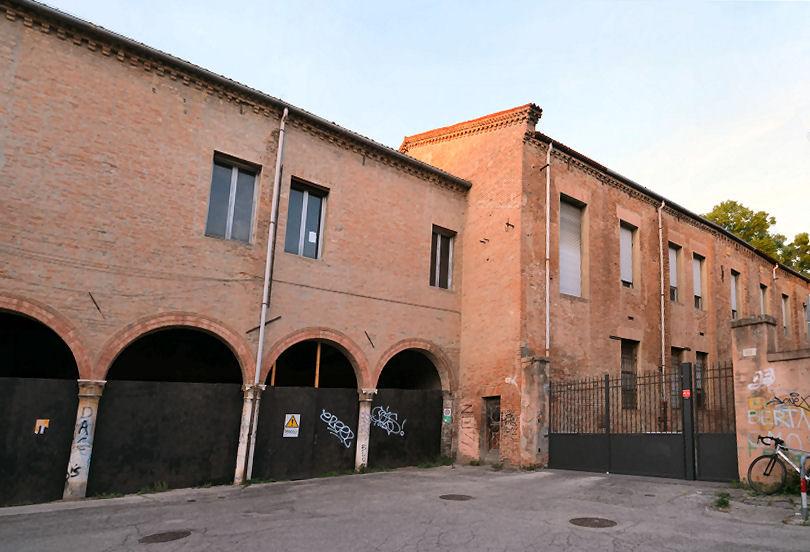
History
Founded, according to legend, by three sisters of the Marano family in 1290, and in 1298
adopting the rule of Saint Benedict under the Beato Antonio da
Brecia. But the Augustinian Ermitani may have been here since 1227.
Surviving a fire in 1345 and the plundering Venetians in 1478, the
complex was enlarged and rebuilt by Duke Ercole I in 1496/7, but land was taken
from the nuns to build the Palazzo dei Diamanti and for the Trotti
Palace, both on the via degli Angeli, and parts of the Herculean
Addition.
The convent was suppressed in 1796 but some of the complex
having been used as a barracks, the headquarters of the Napoleonic
Royal Gendarmerie and in 1813 as a military hospital. Later uses
include a veterinary
clinic, by schools and as a natural history museum.
Work in the 1930s and 1960s has left the complex
looking very institutional. Seriously damaged in the 2012 earthquake, the
complex was the subject of safety and restoration works begun in
2019 and supposedly due to take 90 days. The church is now a gym and
the complex still houses a
school, judging by the graffiti, but nothing approximating a church
is visible from outside. The complex recently featured on property websites,
with suggestions of possible conversion to tourist accommodation.

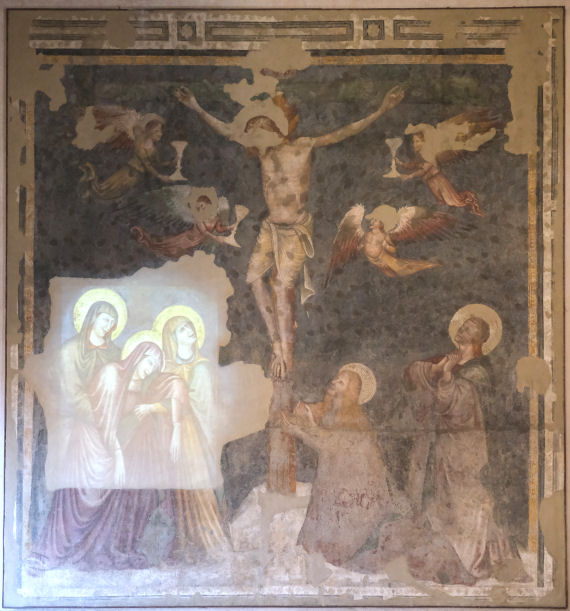
Lost art
Late-14th-century frescoes, including a Last Judgement, were
painted over in the 17th century and revealed in 1930, removed
between 1934 and 1937,
transferred to
canvas and partly lost due to decay. They are now in the main
hall of the Casa Romei and the subject of a conference in Ferrara in 2017. They also include
saints, the Doctors of the Church and a large Giottesque Crucifixion
(see right). The latter is missing three Marys, including the
Virgin, who are now in a private collection, this fragment being
reinserted with a projection in the gallery. Other frescos went to
the Pinacoteca.
Sebastiano Filippi (Bastianino) a large altarpiece of The
Living Cross from 1565-1570, for this church, now in Berlin (see
above right).
Opening times
The church is now a gym, the
complex being part of a school.
|
|
Santa Francesca Romana
via XX Settembre |
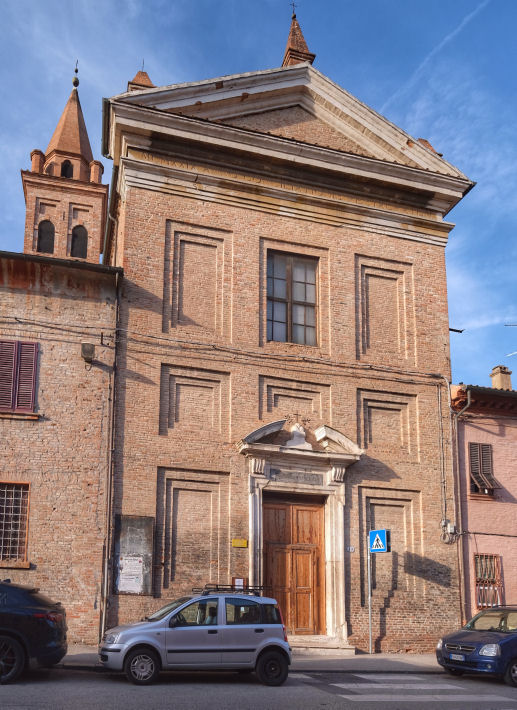
History
Originally a small oratory called San Giorgio della
Ghiara, known as San Giorgino, built in 1569 by Olivetan monks from
the nearby church of San Giorgio for their monastery here. Following
the purchase of more land in 1617 the current church was built from
1619 to designs by Alberto Schiatti. Alberto had died thirty years
previously and so it's possible that his designs were used after his
death or maybe that a mistake had been made and it was his namesake
who died in 1664 who had been employed. It's more certain that the
work was completed in 1622 by Giovan Battista Aleotti, who was
responsible for the façade and campanile, with the church that year
dedicated to Saint Frances.
Francesca Bussi de' Leoni was a Roman saint, a
noblewoman who founded a convent in 1425, dedicating herself to the
care of the poor and sick. She was canonised in 1608 and in 1925
made the patron saint of drivers, because her path was always lit by
angels.
The previous oratory became the
sacristy. Renovation and enlargement between 1872 and 1874, carried
out by Pietro Ghelli, funded by the impressive inheritance of the
then parish priest Ernesto Baroni - the apse was reinforced, the
choir rebuilt and the church acquired five altars. Rising damp led
to need for work on the floor in the early 20th century. Between
1929 and 1931 the facade was restored. In 1932 the complex's
refectory was converted into a theatre which later became a cinema.
In the 1950s the Opificio delle Pietre Dure in Florence carried out
restoration work on the the high altar and in the 1970s the stained
glass windows were restored.
Interior
The first chapel on the
right has the Crucifixion and the Holy Fathers in Limbo from
1614 by Ludovico Carracci which was originally the high altarpiece.
The first altarpiece on the left is The
Virgin and Child Presents the rule of San Benedetto to Blessed
Bernardo Tolomei by Giacomo Bambini
The
second altarpiece on the left is a
Santa Francesca Romana Receives the
Child from the Virgin
painted by Camillo Ricci, a pupil of the Scarsellino.
The Renaissance-style Virgin and Child
that adorns the last altar is by Scipione Azzi, an 18th-century
artist operating in Ferrara.
The stucco statues of The Four Evangelists on the
sides of the altar and nave are by the Ferrarese sculptor Filippo
Porri in collaboration with the Genoese Tommaso Gandolfi.
Bibliography La Chiesa Di
Santa Francesca Romana tra Fabbrica e Storia nella Ferrara
Dell'Addizione di Borso d'Este is a free pdf that you can
download
here
Opening times
For services
|
|
Santa Giustina
Piazzetta Cortebella |
|
Santa Libera
Via Camposabbionario |
|
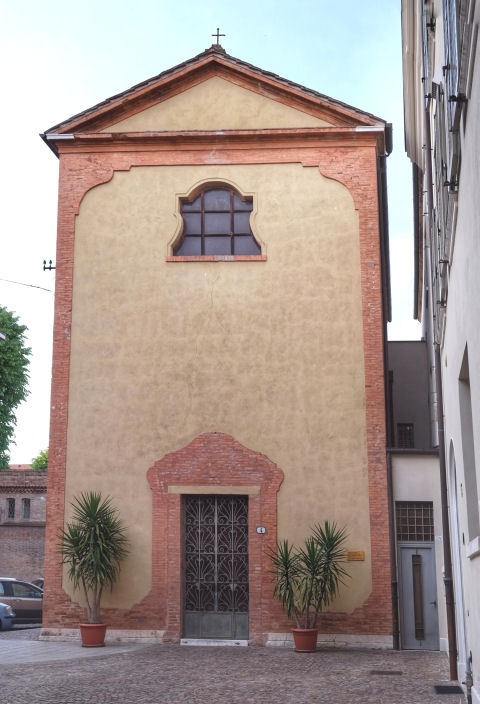
History
Some sources claim that the first church here was built in 800.
A church and orphanage were probably here before 1000, the
complex certainly was here in the 12th century when it consisted of
a parish church and two hospitals. In 1583 it became the seminary of
the Chierici Rossi and in 1721 a school for girls. In the 16th
century the church was rebuilt with a hall plan by Giovan Battista
Aleotti and enlarged with the addition of a campanile in 1769. The
interior was later made octagonal by architect Antonio Foschini and
of the exterior only the doorway remained unchanged. In 1832 the
nuns from San
Guglielmo were moved here and in 1916 Augustinians. The
church recently came back into use and some of the former convent
has become private housing, although 12 Augustinian nuns are said to
remain.
Interior
18th century. The high
altarpiece is a painting of The Martyrdom of Saint Justina by
Francesco Parolini.
The body and head of Saint Sigismondo, King of
Burgundy were kept at the altar. More of his relics are in Padua.
Lost art
Two small paintings by Scarsellino.
Opening times
For services
|
|
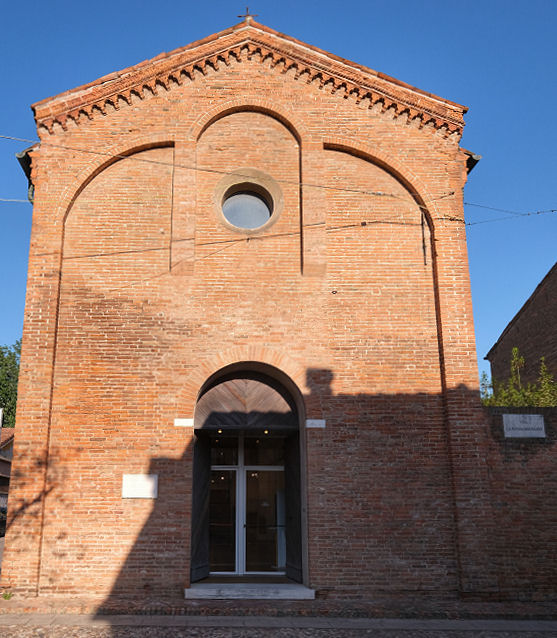
History
A small hall oratory was built here in the 15th century
by Cavaliere Antonio Angelici for the Augustinian friars from the
nearby Sant'Andrea.
The church was dedicated to Santa Maria delle Grazie, referring to a
miraculous image of the Virgin to be found close to the convent of
Sant'Andrea. This icon also had a representation of Santa Libera so
locals began calling the church Santa Libera or Santa Liberata.
In 1556 the Arte dei Muratori (guild of masons) acquired the
church and restored and embellished it. Suppressed by Napoleon it
became a warehouse, stables, horse hospital, laboratory and, during
WWII, a metallurgical workshop, until 1979 when it underwent
restoration to become the Ferrara lapidary museum, containing
ancient sarcophagi.
Lapidario Civico Hours 10.00 -
7.00 Closed on Monday
The Lapidary can be visited on a joint ticket with the Palazzo
Schifanoia.
|
|
|
|
Santa
Lucia
via Ariosto |
|
|
|

History
Built 1537-82, the church of an
Augustinian, or possibly Dominican monastery, its building involving
Duke Ercole II d'Este . The convent was closed in 1903, becoming the
Umberto I Orphanage, with the church remaining open. The
complex has undergone restoration to become a student residence.
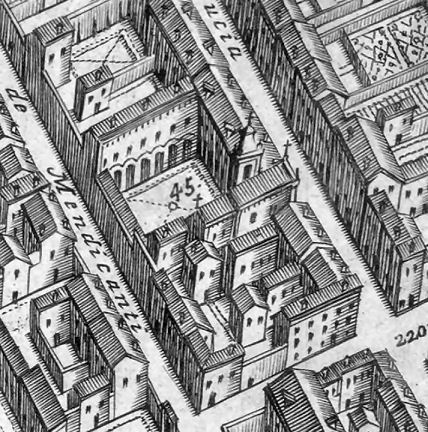
Lost art
A Virgin and Child with Saints Lucy and Matthew and an angel by Bastianino
from c.1582, is in the Pinacoteca.
|
|
Santa Margherita
Via de' Romei |
|
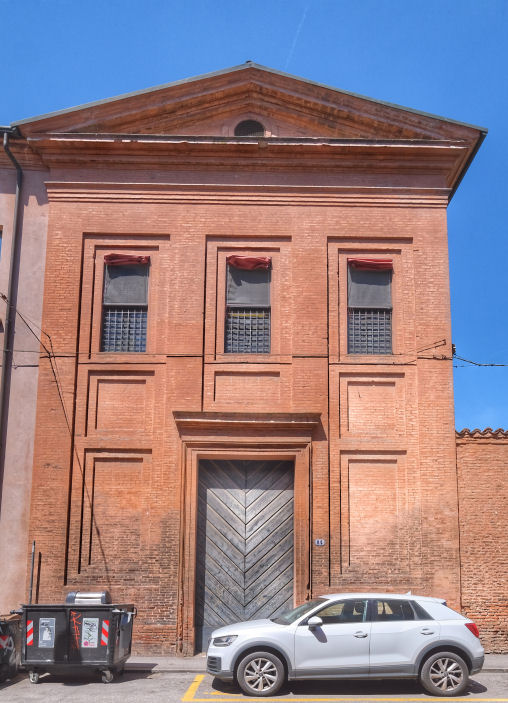 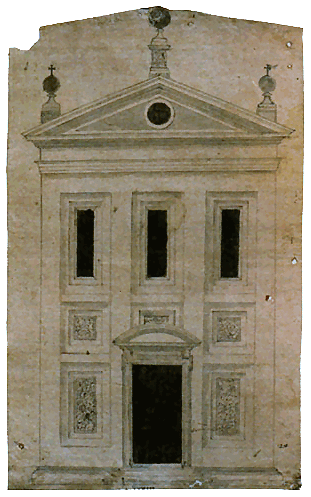
History
The church was built c.1604 to plans by Giovan Battista Aleotti, at the rear of the old Pendaglia Palace
which had been sold in part to the Conservatorio delle Zitelle di
Santa Margherita, who then began the construction of the church.
The complex was closed in 1796 by Napoleon and
used as a warehouse. In 1845 it became an
old-people's home,
following a fire in 1831 which damaged the painted and coffered
ceiling. In 1848 it became the fire brigade HQ and was later a gym,
until it passed to the Orio Vergani hotel institute.
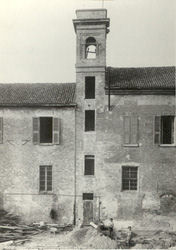 The interior had frescoes (fragments?) by Scarsellino, Carlo Bononi
and Bastianino. Also a late Gothic loggia to the cloister. The interior had frescoes (fragments?) by Scarsellino, Carlo Bononi
and Bastianino. Also a late Gothic loggia to the cloister.
Campanile
Demolished in 1913 (see photo right).
Opening times
Currently closed
A drawing by Aleotti
|
|
Santa Maria dei
Servi
via Cosmè
Tura
|
|
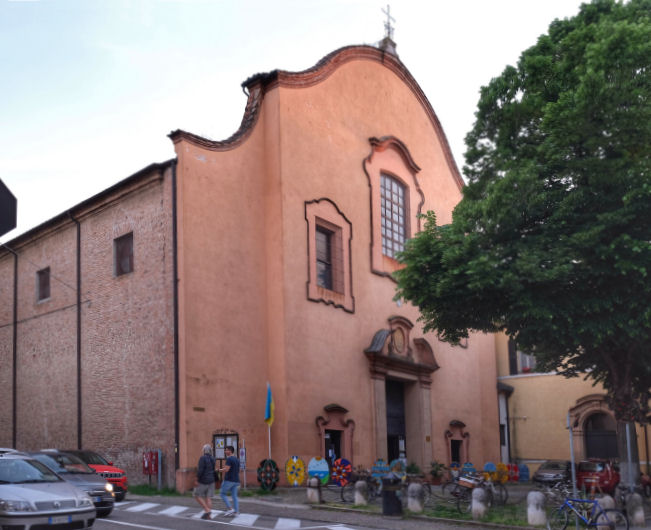 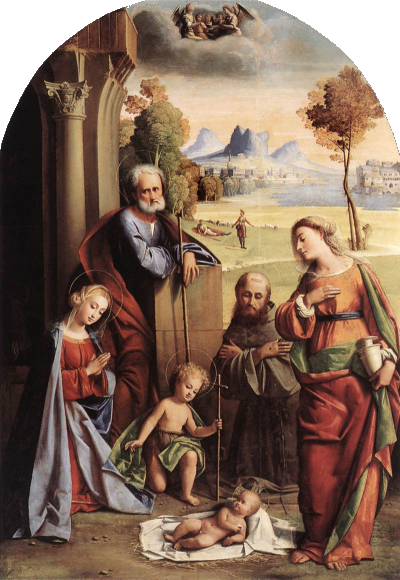
History
Built in 1669 to designs by
Luca Danesi, and finally completed, along with the attached convent, in the
18th century by the brothers Francesco and Vincenzo Santini, for
Servite nuns after their previous complex, which they'd
occupied since 1339, had been demolished in 1633 to make way for the
papal fortress.
Now being used by a Ukranian Orthodox Byzantine congregation.
Lost art
A Nativity with Saints by Ortolano from the 1520s (see
right) went to Rome in 1527. It is now in the Galleria Doria
Pamphilj there. It was later replaced here by a copy, which a
guide of 1770 records as then located in the sacristy.
Opening times
For services
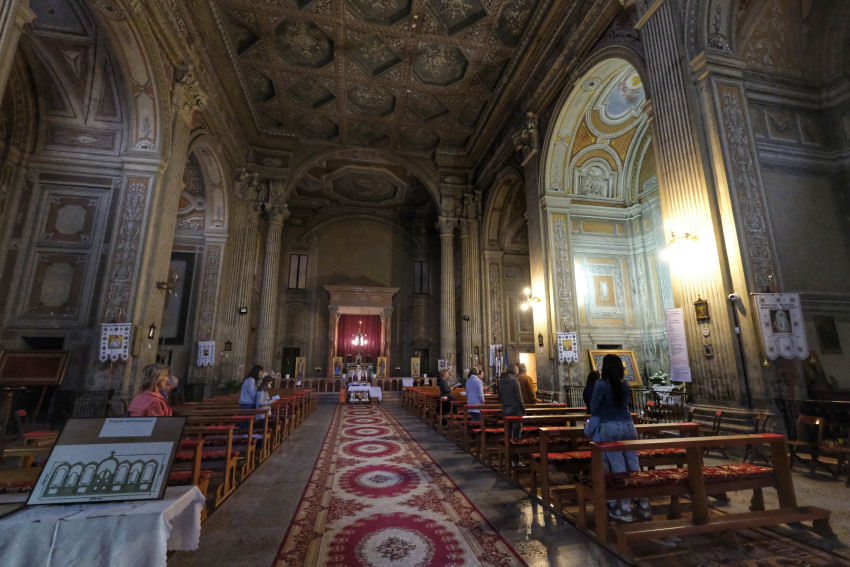
|
|
Santa Maria dei Teatini
Santa Maria della Pietà
Corso della Giovecca |
|
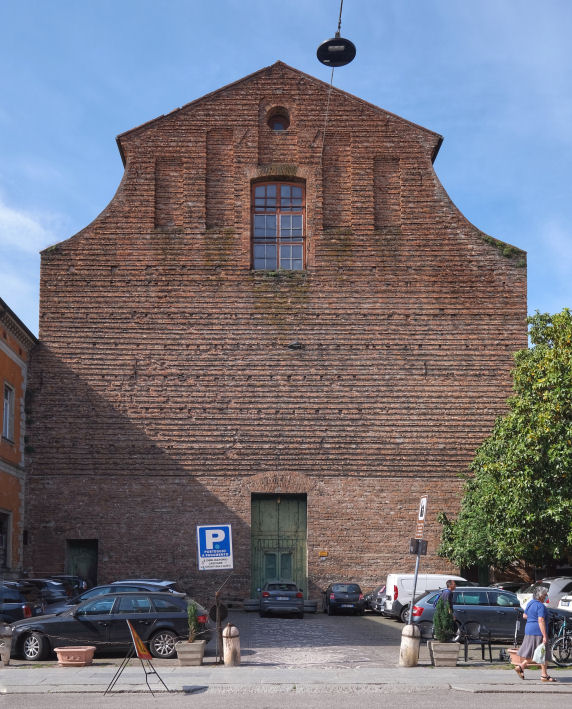
History
In 1618 at the instigation of Laura Sighizzi and Cardinal
Carlo Emanuel Pio of Savoy an oratory for the Theatine order dedicated to Santa
Maria della Pietà was established here. Luca Danese designed the Baroque church,
which was begun in 1622 and completed in 1653. Closed and crumbling since the 2012 earthquake,
with services now held in the oratory. In August 2020 it was announced that a
project to survey the convent with a view to converting it to offices for the
Ministry of Justice and the Ministry of Labour had begun.
Interior
Typical late 18th century baroque.
The choir has frescoes of the Life of San Gaetano, the founder of the
Theatines, by Clemente Majoli, who also frescoed angels on the ceiling of a
chapel near the presbytery, which also has works by Scarsellino.
To the right of the presbytery is a canvas depicting John the Baptist by Andrea Sacchi.

The presbytery has a Presentation of the Virgin (Madonna delle Colombine) of 1654/55 by Guercino.
It was
commissioned by the lawyer Claudio Bertazzoli for his family chapel
in the church in 1654, with the final payment recorded the following
year. I've also read that 'The painting remains in the church today,
the third altar on the left'.
Sant'Andrea Avellino was painted by Camillo Ricci.
The ceiling of the sacristy
is frescoed with a Glory of San Gaetano by Alessandro Naselli. In the first
chapel is a San Gregorio by Francesco Costanzo Catanio. Another chapel has a
San Gaetano and a Resurrection by Alfonso Rivarola known as il Chenda. Also a
mystery artist Abramo Scoccese (Scottish) has a Transit of St. Joseph
here.
The nave walls have canvases depicting the Life of San Gaetano by Cesare Mezzogori.
He also painted friezes of chiaroscuro angels on the ceiling and canvases around
the Altar of the Purification of the Virgin. The latter work being completed by
Giovanni Battista Felletti, who painted a San Gaetano and the Child.
Some of the marble used to decorate the interior came from the Delizia di
Belfiore, the famed palace of the Este.
Relics and tombs
Under the altar of Saint John the Baptist are the remains of San Secondino, Bishop
and Martyr and in the chapel of the Virgin of the Graces, are the relics of San
Faustino Martire, both transported here supposedly from the Cemetery of Santa
Lucina in Via Aurelia outside Rome. General Antonio Domenico Balbiani is buried
in the last chapel. He defended Ferrara for Pope Clement XI and was named Grand
Prior of Armenia and Grand Admiral of Malta.
The oratory
The oratory of the Theatines (see right) which has a door on via Cairoli, has more art. The high altarpiece
is a Santissima Virgin by Costanzo
Cattani. In the walls of the oratory are canvases depicting an Annunciation by
Giovanni Braccioli; a Purification at the Temple by Camillo Setti; a Flight to
Egypt by Alessandro Naselli, and others by Tommaso Capitanelli. The ceiling was
painted by Francesco Ferrari.
Opening times
Currently closed
|
|
Santa Maria del Suffragio
via San Romano |
|
 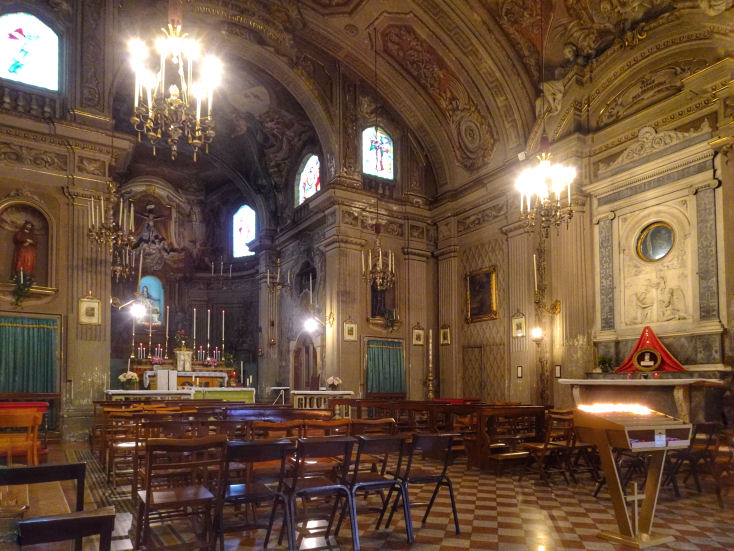
History
Built in 1623 as an oratory for the Confraternita del
Suffragio by the brotherhood's founder, also the canon of the
Cathedral and vicar of the church of San Romano up the road. Rebuilt
in 1750 by Gaetano Barbieri.
Interior visited
An aisleless hall nave with two side altars - a sweet
little square grey Baroque interior, with a deep choir, stained
glass, every surface decorated, mostly in a grisaille way, and
subtly gilded.
The nave vault decoration is the work of local early-18th-century artist
Giuseppe Facchinetti, with the central painting by Ettore Parolini.
The vault of the presbytery and the choir has paintings by
Alessandro Turchi. A niche in the choir has a Virgin and Child
by Lorenzo Gherri.
Over the left altar is a Marriage of the
Virgin by Leonello Bononi from c.1630. Over the altar on the
right is the venerated Pieta (called the Madonna della
Racchetta) placed here in 1808 having been originally located in
the nearby via Vespergolo and then in the church of San Romano. It
is framed with a marble neoclassical bas-relief from 1832 by the
brothers Francesco and Mansueto Vidoni through which the
Madonna della Racchetta
is viewed as through a porthole (see the right side of the photo
left). At the same altar the
Blessed Alberto Marvelli, a local engineer and politician beatified
in 2004, has been revered since 2003.
The organ on the counter-façade, dated 1551 , is the work of
Giovanni Cipri and came from
Sant'Antonio in Polesine.
|
|
Santa Maria della Consolazione
via Mortara |
|
History
This church marks the spot where a nobleman from Ferrara,
on his way to one of his farms outside the city in 1189, ran into some bandits
and after appealing to the Virgin for assistance escaped unharmed. He rode
home and returned with a painting of the Virgin. In 1189 a small oratory was
built to house this image of the Virgin and miraculous healings duly followed.
(This image is no longer to be found here)
As the oratory's popularity grew Duke Ercole I was asked to finance the building
of a church next to the oratory. So on April 5th 1501 the first stone was laid
by the Duke, to designs by Biagio Rossetti it is very
tentatively
claimed, with the work completed on March 16, 1516 and the miraculous icon
installed the same year. Consecration, however, didn't happen until September
1524. A convent was also built from 1500 for the
Servites, inspired by the preaching of Fra Marino Baldi at the Duomo that year.
A Fra Marino who was confessor to Sigismondo was buried here in 1518.
Marfisa d'Este was buried
here in 1608, but her tomb was later moved to the Certosa. In 1781 the convent
was suppressed by Pope Pius VI, with the
church passing to parish use. In 1883 the church was closed for worship and put
to various uses - as stables, a military warehouse (in 1877), a garage for
funeral cars, a military hospital (in 1916) and a municipal warehouse. The fittings and furnishings
were distributed
among the other churches of the diocese. In 1964 the church and cloister were
restored by the Ferrariae Decus association and the Ferrara savings bank and in
1971 reopened for worship. The church has been closed since the earthquake
of 2012, but a news report in September 2019 claimed that work had begun which
was due to be completed in April 2021 'barring unforeseen circumstances'.
The façade
Unfinished.
The entrance porch was originally to become part of a narthex, as can be seen in
its ragged chopped-off appearance at the sides.
Interior
A nave and two aisles, in the apse dome is a fresco from the
early 16th century depicting The Coronation of the Virgin, a work formerly
attributed to local artists, it has recently begun to be attributed Baldassare
Carrari.
Lost art
A 16th century plaster relief of the Virgin and Child is in the
Casa Romei.
Opening times
Currently closed
|
|
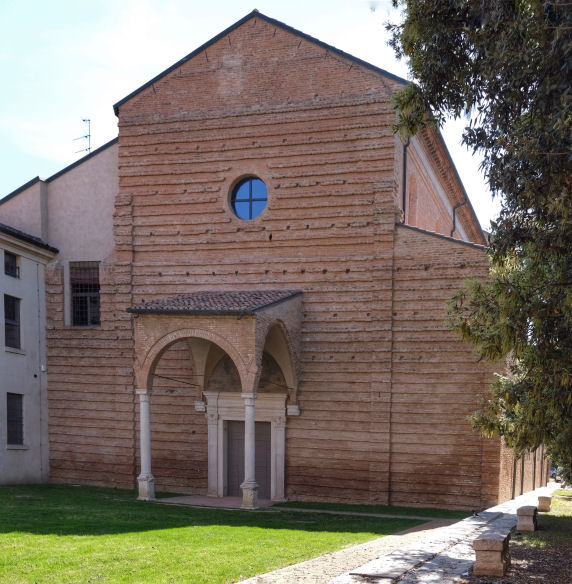 |
|
Santa Maria della Visitazione
(Madonnina)
via Formignana and Carlo Mayr |
|
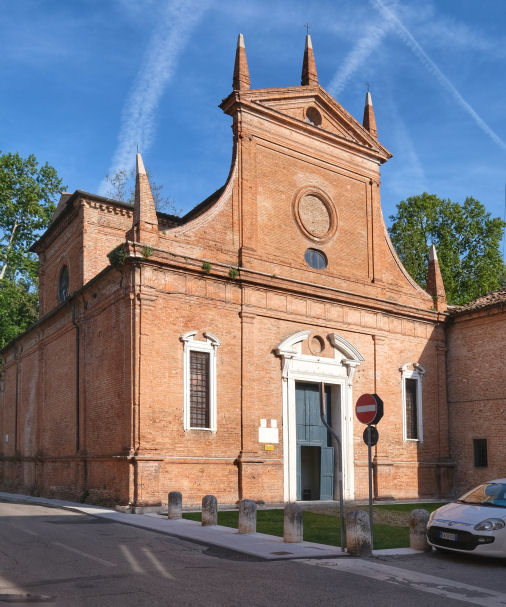
History
Built in 1526 to house the very venerated fresco of The Madonna
della Porta di Sotto, by which name the church was sometimes known.
The fresco had survived the demolition of the Port di Sotto
and the medieval
walls by Alfonso I d'Este in 1510.
The church was damaged by the 1570 earthquake and was restored with
a rebuilt façade by Alberto Schiatti. Consecrated in the 1630s,
it had passed to the Camillians in 1615, who were here until 1797.
After Naploeonic
suppression it became state property in 1810 and was reopened for
worship in 1813. Again officiated by the Camillians, it then passed
to the Missionari del Preziosissimo Sangue (Missionaries of the
Precious Blood) and then became a parish church in 1957.
Interior
A Greek cross.
Art
The Madonnina by an anonymous 15th-century Ferrarese master. Saint Jerome by Bastianin, two paintings by Gaspare Venturini
(16th century) and a canvas with
Christ descending from the cross towards Blessed Lutgarda .
Lost art
A Deposition by Ortolano from 1515, now in the Galleria
Borghese in Rome, was removed from this church in 1607 following
Ferrara's passing to the papacy, and replaced by a copy.
San Carlo Borromeo in Ecstasy 1611 by Carlo Bononi perhaps
the first image of the new saint from Ferrara, only canonized in
November 1610. It is on deposit at the Civic Museums of Ancient Art.
Opening times
For services
|
|
Santa Maria in Vado
Via Borgo Vado
|
|
History
The church of Santa Maria in Vado, formerly dedicated to the
Annunciation, is first documented here in 971, with an adjoining
monastery. It's called Santa Maria in Vado as you had to cross a ford (vado) to
reach it, in a then otherwise marshy area.
On the 28th of March 1171, during Easter celebrations,
Prior Pietro da Verona was breaking the Host when it turned to real
flesh and drops of blood flew from it up into the apse dome.
This was proclaimed the Miracle of the Prodigious Blood. This being at a
time when Albigensian and Cathar heresies were denying the miracle of
transubstantiation.
In 1477 Ercole I decided to enlarge the monastery by adding
two cloisters. The rebuilding of the church followed, when in
1495 an architect and painter called
Ercole Grandi prepared the drawings for the façade, the interior and
the marble decoration. (Vasari mixed the architect Ercole up with
Ercole de’ Roberti, the painter, a mistake which was corrected in
1914 but which is still all over the internet and in guidebooks.)
Some claim that Ercole Grandi was a favourite pupil of Lorenzo Costa, others
that he's a myth.
This work was undoubtably executed by Biagio Rossetti and Bartolomeo Tristano,
with Antonio di Gregorio. The rebuilding finished, the church was
reconsecrated on 18th April 1518. In 1519 there was further work on
the interior, by Tristano again. Restoration work 1829-35
by Tosi to make the building safe, at which time many paintings were
moved to the Pinacoteca.
Interior visited
Mostly minor 16th and 17th century art, the five highlights, on the nave, transept and apse ceilings are
all the work of
Carlo Bononi
1617, framed by 17th/18th century illusionistic ceiling painting by
Girolamo Faccini, Ippolito Casoli, and Girolamo Grassaleoni.
The
deep aisles have six
altars each side, the right
aisle is
currently (May 2022)
fenced off.
Work by Bastianino (Sebastiano Filippi) and Camillo Filippi,
his son, who painted The Annunciation
over the high altar.
The works of Dosso Dossi, Bastianino,
Panetti
and Carpaccio are copies, the last two by Gregorio Boari, the originals, are now in the
Pinacoteca. An Ascension by Bononi is a copy of the Garofalo
from 1510-20,
now in the Galleria Nazionale d'Arte Antica in Rome. There is a 15th century Byzantine M & C, called The Madonna of
Constantinople in fact, over the fourth altar, attributed to Antonio
Rizo. An Ascension by Bononi is a copy of the Garofalo
from 1510-20,
now in the Galleria Nazionale d'Arte Antica in Rome. There is a 15th century Byzantine M & C, called The Madonna of
Constantinople in fact, over the fourth altar, attributed to Antonio
Rizo.
The deep transept has the
organ at the left end and the famous Cappella del Prodigio
containing the Santuario del Preziosissimo Sangue, covering the
right end (see photo right) a temple-like structure built in 1595. It commemorates the Miracle of the
Prodigious Blood when, on Easter Day 28th March 1171 while mass was
being celebrated by prior Pietro da Verona blood from the host splashed onto the
vaulting of the semi-dome of the apse of the old church. This being
at a time when the idea of transubstantiation was being challenged
by Cathars and the like. The sangue-splashed dome was moved into the upper level here, but
with some loss of the miraculous stains,
accessible up stairs and behind glass
Tombs
Garofalo was buried here.
In 1696 Carlo Brisighella had a plaque placed on (his grandfather) Carlo Bononi's tomb here.
Lost art now
in the Pinacoteca
The Death of the Virgin by Carpaccio
dated 1508, from the baptistery (high altar?) here, where it
remained until 1836. It is not known how it came here or who was
responsible.
The Tribute Money, which has been
attributed to many down the years, but now to Giovanni Cariani. A Visitation
and an Annunciation by Domenico Panetti. An
Assumption of Mary Magdalene by Ercole Grandi.
A Virgin and Child Enthroned with the Infant John the Baptist and
Saints Agatha, Apollonia, Lucy, Helen, Catherine and Maurelius,
a nun and two donors panel from c.1513 by Michele Coltellini,
a painter of low repute who probably studied under Lorenzo Costa.
A Virgin and Child Enthroned with Saints Roch and Anthony Abbot
from 1530, painted for the first altar on the left here
in 1530 by the Master of the Twelve Apostles.
Saint John on Patmos by Dosso Dossi.
A Virgin and Child in Glory with Five Saints (see right)
from the Da Varano chapel here, moved to the sacristy in 1933, and
now in the Archbishop's Palace, since 1945, may be by Dosso Dossi,
but is likely not. The identities of the saints changed during
restoration work in 1983, when later overpainting was removed.
In the process the two female saints behind the foreground male
saints lost a salver with breasts upon it and pincers holding a
tooth, and so were no longer Lucy and Apollonia, becoming a mystery
and Saint Catherine, respectively. Saint Peter, far right, lost his
keys but is still Peter, balanced by Saint Paul far left. The
central saint was thought to be John the Baptist but the cleaning
revealed an inscription identifying him as Saint Matthew.
A Vision of Saint John the Evangelist
of c.1533-4 by Battista Dossi, the younger
brother of Dosso, commissioned by the Augustinian Canons for their
altar here, has been in the Pinacoteca since 1836.
Saint Cecilia from c.1598-1602, painted on canvas by
Bastianino for the family chapel of Antonio Goretti here.
Lost art not
in the Pinacoteca
An Ascension by Garofalo from 1510-20 is
now in the Galleria Nazionale d'Arte Antica in Rome. It was taken to
Rome after Ferrara passed to the papacy in 1598. A copy
by Bononi remains here.
Opening times
8.30-12.30 & 3.30-7.00
holidays 9.00-12.30, 4.00-8.00
|
|
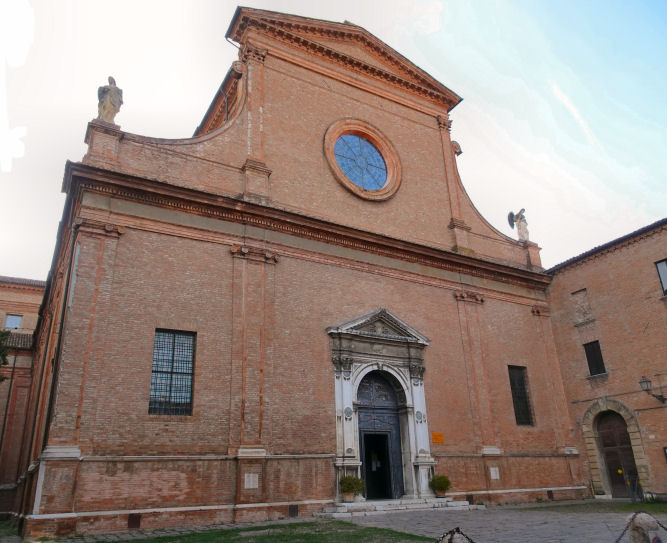
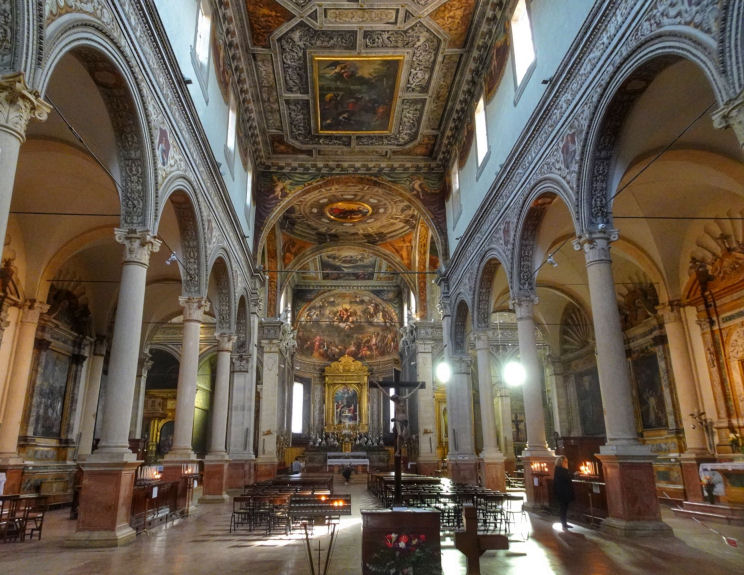
 |
|
Santa Maria Nuova
Santa Maria Nuova e San Biagio
Via
Aldighieri |
|
History
Local tradition reports a small
lake here, on an island in which was built a small church called Santa Maria dei
Pescatori "of the fishermen". Nearby was built another larger church
called Santa Maria del Lago in 911. In 1182 it was rebuilt and acquired acquired its current form
and name, documented as a parish church in 1278. Work
carried out in the 14th and 15th
centuries involved the building of chapels by the Contrari and Bonlei families.
Later decline was halted in 1708 when the
church of San Biagio, which was on the corner of viale Cavour and via Cittadella, was demolished.
The parishes were merged and in 1709 a
chapel dedicated to San Biagio (Blaise) was built in here to house
the jaw relic of the saint,
which is still locally venerated as a
cure for throat ailments, especially on the saint's day on February 3rd.
At this time his name was added to the church's dedication. Closed
by Napoleon in 1796, it reopened in 1812 but not as the parish church
At the end of the 19th
century renovation work on the floor was carried out and the tomb of the Aldighieri
family, thought to be ancestors Dante Alighieri,
was found under the high altar, along with traces of the wall of the
ancient church. Dante's kinship with the Aldighieri is not certain, but the 15th
canto of the
Divine Comedy and a testimony of Giovanni Boccaccio mention the Ferrarese origins of the poet's ancestors.
More restoration work in 1921, including creating a crypt to preserve the Aldigheri tomb
(see small photo below) and deeper digging. The 18th century work on the façade was
also reversed, returning it to its 15th century gothic appearance. The
large Transit of the Virgin
fresco sinopia from the mid 15th century was found in the ogival
door arch during this restoration of the facade and a
Dante-related plaque, quoting Canto 15, was installed. The church
returned to parish use in 1938 and bombing in 1944 caused much
damage with reconstruction following and finishing in 1950. The 2012
earthquake forced the church to close. It reopened in late 2015.
Interior
Aisleless with grey stone detailing. No side altars - they
were removed in 1938. The ceiling has trompe l'oeil coffering with a
painted panel showing The Miracle of San Biagio, healing a
child in the centre. The apse semi-dome is frescoed. The high
altarpiece is The Miracle of the Snow by Scarsellino from c.1600/10,
which is said to have had side panels of saints and narratives by Mazzolino. A 17th-century wooden Crucifix by Tommaso Gandolfi .
Lost art
A fresco fragment of The Virgin and Child by an artist in the
circle of the Maestro di Casa Pendaglia was detached from this
church in 1952, and is now in the Casa Romei. Removed at the same
time was a sinopia of The Dormition of the Virgin from the
mid-15th century in the pointed arch over the portal. It's in the
Casa Romei now too.
Opening times
For services

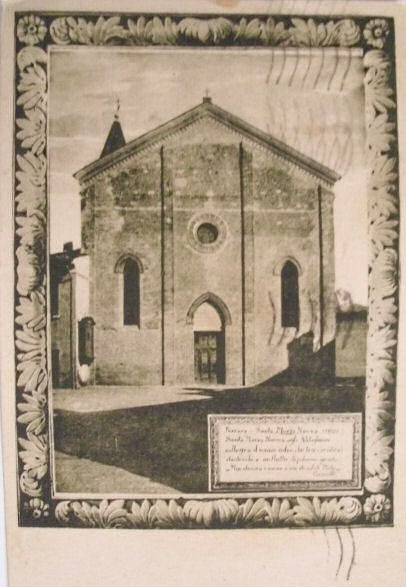 |
|
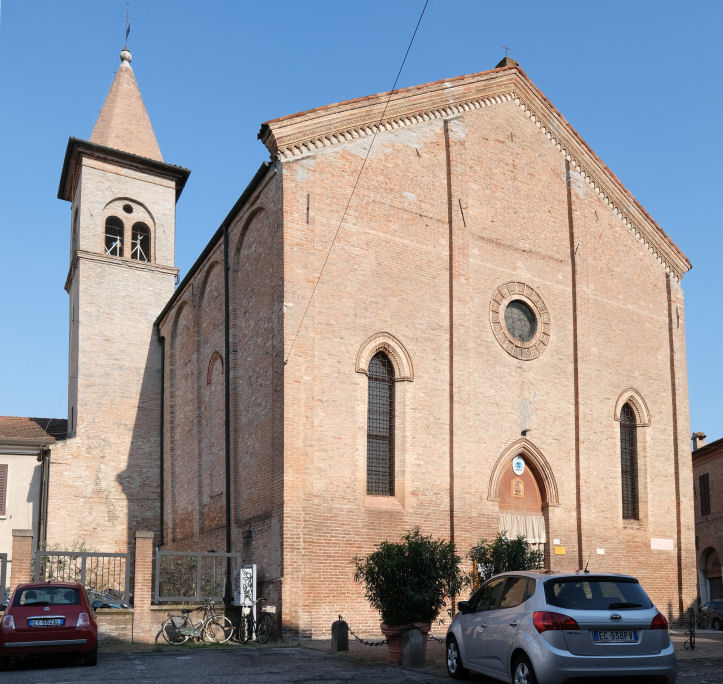
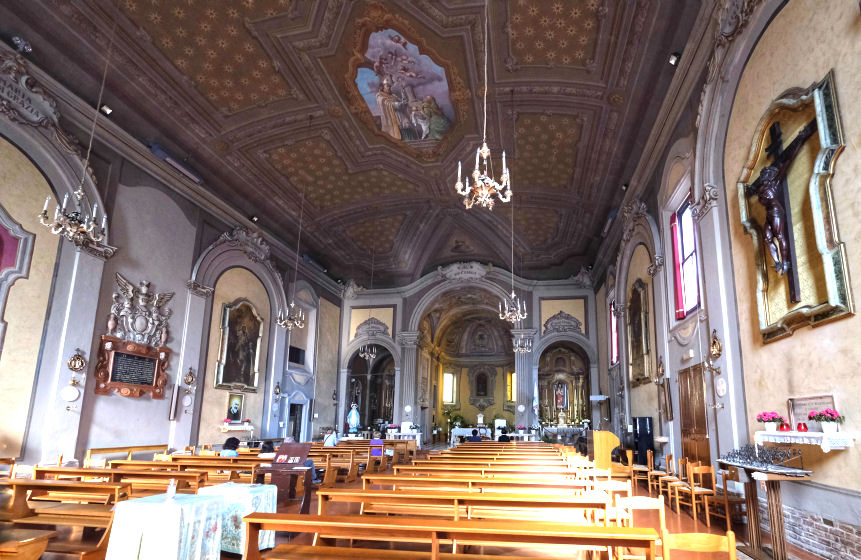
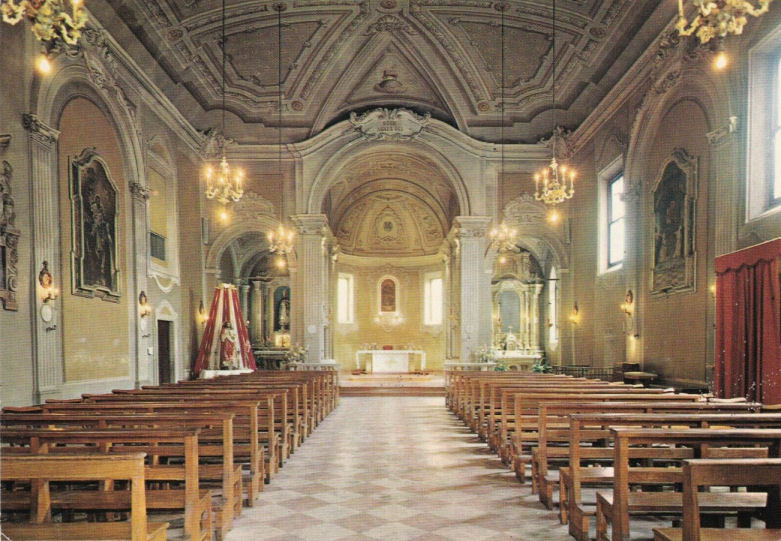
Left and above: postcards.
|
|
Santa Monica
Via Montebello |
|
Santa Teresa Trasverberata
Via Borgovado
|
|
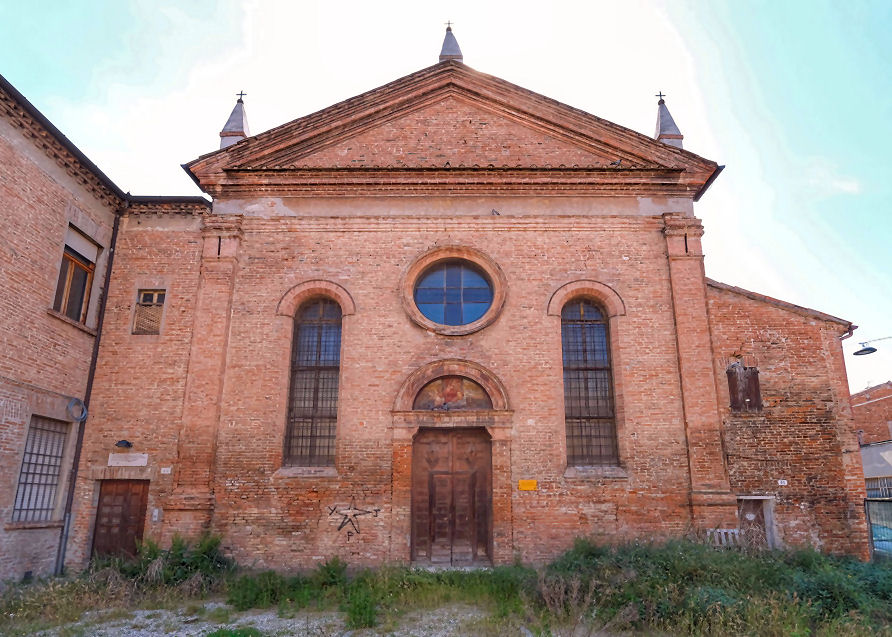
History
The church and convent were
founded in 1515 by nuns who had parted from the convent of Sant'Agostino
under a cloud of controversy, involving murder. They received the help of Duke
Alfonso I and his wife Lucrezia Borgia, and designs by Gherardo Saraceni. Work
began on the 2nd of July 1515, with consecration by the bishop of Comacchio Gillino Gillini on
the 13th July
1544. Following the Napoleonic suppressions in 1796 the complex became private
property. In 1815 it was rented to Carmelite nuns, who were ejected shortly
afterwards, when it was reacquired by the Municipality. In 1869 they were able to
return, but in 1950 they left for good. The cloister currently houses a school.
The church currently (May 2022) crumbles behind weeds and metal
fencing.
Lost art
The Virgin and Child lunette over the door by Garofalo
was in such
poor condition due to the depredations of the weather that it was
replaced in 1940 with one by local artist Mario Capuzzo which
was returned
following restoration work in 2015.
An Annunciation of 1550 painted by
Garofalo for this church is described by Edmund Gardner in his 1911
book The Painters of the School of Ferrara as the artist's
last work and 'deplorable'.
A 1484 panel, originally part of a polyptych, by Cosmè Tura depicting Saint Nicholas of Bari is now in the Musée
des Beaux-Arts in Nantes.
Opening times
Currently closed
|
|

History
In 1739 five Discalced
Carmelite nuns, allied to the Discalced Carmelite fathers from
San Girolamo,
began to meet in a house nearby. One house became four, and then a church was built
to plans by Gaetano Barbieri, starting in 1781 and completed in 1788. In that
year the temple was consecrated too, to the Transverberation of the Heart of
Saint Teresa of Jesus. Saint Teresa of Avila being the founder of the
order. The baroque decoration of the interior began around the same
time. Restoration work in 1923 and decoration in 1931 by the
Ferrarese painter Augusto Pagliarini, also responsible for two
paintings flanking the main altar showing two scenes from the life of Saint
Teresa, with two tondi above of two Carmelite Blessed nuns.
Suppressed by
Napoleon, but in 1821 the nuns were able to return to their partially demolished
convent with some new building. Restoration work on the church from 1923,
which involved the replacement of the old high altar with one made of white
marble, and a reconsecration in 1939.
Interior
A circular plan, topped by a dome and a lantern. Two paintings
attributed to the 18th century Ferrara painter Francesco Pellegrini.
Opening times
Update May 2024 The church has the builders in.
|
|
Santi Cosma e Damiano
Via Carlo Mayr |
|
Santi Giuseppe, Tecla e Rita da Cascia
Via Carlo Mayr |
|
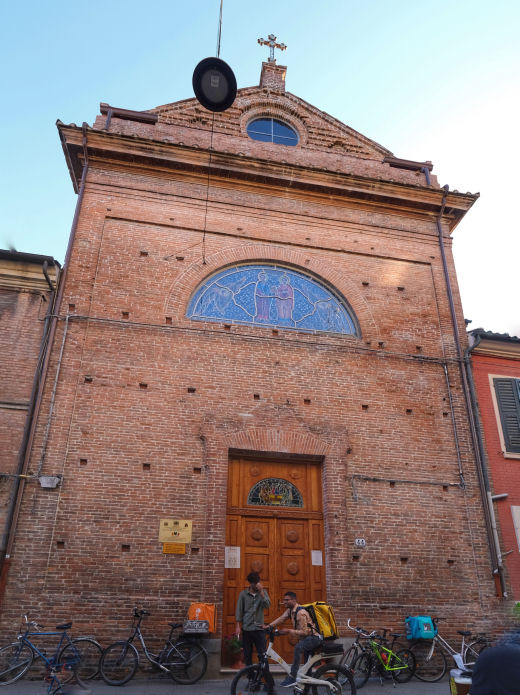
History
The church, an oratory for
the guild of apothecaries, was built by the architects Francesco and Angelo Santini from 1710 to 1738 based on plans by Francesco Mazzarelli.
The church closed in 1933 and was later used as a warehouse.
In 1986 it was bought
by the Municipality and used to house magazines and periodicals from
the (quite) nearby Ariostea municipal library. Damaged by the 2012
earthquake, in 2015 the church was purchased by the Romanian
Orthodox community of San Nicodemo di Tismana who restored it and
began using it in 2020. They paid, in instalments over 5 years, 175,
000 euros. They had previously used the churches of Santa Chiara
Vergine and Santa Francesca Romana.
Interior
There are 10 large life-size stucco statues of the Evangelists and the doctors
of the church and four terracotta busts from 1736 by Andrea Ferreri.
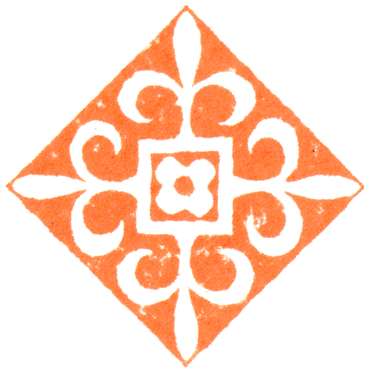
|
|

History
The Marquis Camillo Zavaglia was
intent on bringing the Order of the Discalced Augustinians to
Ferrara and on 11th February 1623 they were given the church of
Saints Simon and Jude and a house to rent for the monks. Years of growth
followed and in 1627 a license was granted to build the new church,
financed by two benefactors. Four houses were bought and the new
building was finished in a year, completed with further donations,
including that of the Marquise Clarice Estense Tassoni for the high
altar. The license for the construction of a second church was
granted in 1638, based on a design by Atanasio di San Filippo, but
this proved to be inadequate and local architects Carlo Pasetti and
Giovanni de Priori were employed.
Work began on 27th October 1638 and was completed in 1646. Between
1652 and 1656 four chapels were added, two on each side.
Consecration followed on 17th April 1671, by Giulio Bentivoglio
, bishop of Bertinoro, with the church dedicated to Saints Giuseppe
(protector against earthquakes) and Tecla (virgin martyr). The late
17th century also saw the frescoed decoration of the chapels and the
installation of wooden confessionals beside the chapels, and in the
mid-18th century the choir and organ, all the woodwork being of
walnut.
After the Napoleonic suppressions,
in 1796, the convent was used as a girls' school, but was returned
to the Augustinian fathers thirty years later. Following the
suppression of the orders in 1866 by the Kingdom of Italy the
convent was sold on 20 July 1869 to the Municipality of Ferrara,
resulting in the use of the complex as a boys' school. Various
restorations of the church followed, including work on the façade carried out
by Gaetano Faggioli in 1880. The Lateran Pacts of 1929 saw the
church returned to the Augustinian fathers. Bombings during WWII
caused the collapse of the campanile and damage to the facade. In
1949 the church added a dedication to Santa Rita and in 1958 the
campanile was rebuilt. Rebuilding work followed, and
restoration of the furnishings by the superintendency of Bologna.
A plaque on the facade commemorates Alessandro Frighi, a resistance
fighter who had set up a machine gun in the bell tower and, on 23rd
April 1945, was killed by a German sniper
Interior
Baroque, a long aisleless nave nave with two chapels each side. Has a
wooden trussed roof behind a barrel-vaulted ceiling and a
rectangular presbytery.
Much 17th century art and more than a hundred reliquaries.
In the presbytery are five large paintings of various
scenes from the lives of the saints. The frescoes in the apse and the presbytery
were painted in 1688 by the Ferrarese
painter Francesco Scala .
The main altar is decorated with polychrome marble, to a
design of the Jesuit Father Ippolito Sivieri, the urn of St.
Ignatius the martyr is underneath it.
|
|
Santi Piero e Paolo
via Cosmé Tura |
|
Santi Simone e Giuda
Via Belfiore
|
|

History
The first hospital for beggars in Ferrara was built here around 1307. It
won the support of the Este when they came to power. Lucrezia d'Este, in the
second half of the 16th century, was a particularly devoted patron. The church
of the hospital was built between 1563 and 1566. In 1598 the cardinals
assumed control and with the Napoleonic suppressions the duty of care passed to
the state and many religious properties were requisitioned. The complex closed
in 1974.
Photos from a few years ago show the church looking in a far worse state. It's
recent replastering hints at some sort of use.
|
|

History
First documented in the
12th century, in 1278 the church here became a parish church. In 1422 it was
reconsecrated having been rebuilt in Gothic style. In 1735 the building, and an
adjacent house, was bought by the Arte dei Marangoni (carpenters), who made big
changes, including in 1760 demolishing the old marble altar and replacing it
with a wooden one. Work finished in 1763 which involved the loss of the two
Gothic windows of the façade and the creation of a large window in the centre.
The Istrian stone and Verona marble doorcase was kept. In 1763 the church passed
to the Confraternita del Sacro Cuore, called the Sacchi. A new choir was built
later in the 18th century.
With the Napoleonic suppressions the church and attached house were sold by the
state to private individuals, which led to its purchase by Don Luigi Serravalli,
who in 1815 gave them to the Confraternita del Sacro Cuore.
In 1904 the engineer Lorenzo Dotti set about the restoration of the facade, back
to its 15th-century gothic fenestration. During the First World War the church
was closed again for worship and used as an army warehouse. Left to crumble, and
bombed in 1944, resulting in the collapse of the roof. The unsafe roof was
demolished in 1998 and for more than two years the church was left open to the
elements. In 2000 the Cassa di Risparmio di Ferrara took over the building as
the Confraternita dei Sacchi didn't have the resources, and in 2001 the roof was
rebuilt and the walls strengthened. Further work, on the 18th century interior,
was due to be completed in 2004.
Lost art
A high altarpiece by
Scarsellino with Saints Simone and Giuda, painted before
1614, now lost.
A guide book of 1838 by
Francesco Avventi
tells of a high altarpiece showing the titular saint by
Alberto Mucchiati, an artist it describes as well-educated but
mediocre.
|
|
Santissimo Crocifisso di San Luca
Via Giuseppe Fabbri |
|
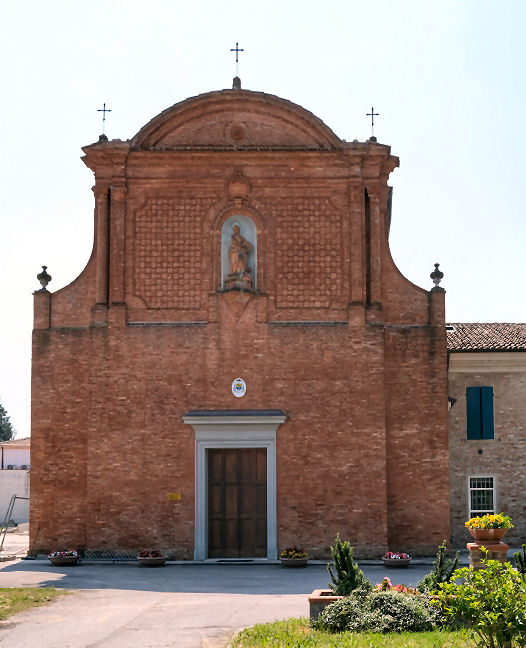 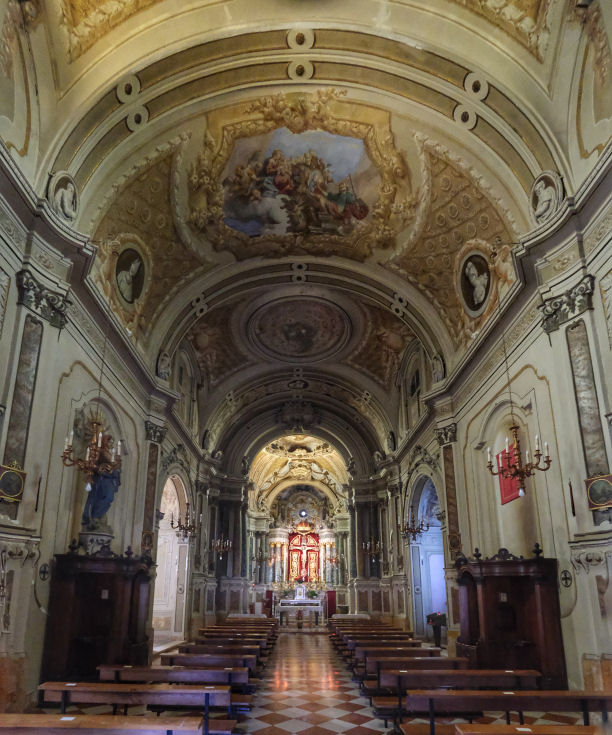
History
It is said that an oratory was built here
by Accarino d'Este in 450, but it's more certain that by 1128 an oratory
dedicated to this saint was here, containing the wooden crucifix from the Capo
Rete beach on the Po where it had miraculously run aground and been hauled here
by a poor man with a thin mule called Luca Finotti. It is said that there had
already been an altar here dedicated to Luke the evangelist by the
Marquis Almerico d'Este in 930. So from this crucifix the church gets its name
and it's still to be found in the apse here. It is attributed to Saint Luke
himself, but is probably 12th century. The church was consecrated in 1135 by
Bishop Landolfo. It was severely damaged by a flood on 22nd October 1654, but
immediately rebuilt, very baroquely inside. In 1768 the high altar and apse
were finished and in 1785 the current structure was completed. This work being under
the direction of Don Luca Bonetti, rector here from 1760 to 1816. He also
implemented the building of a long portico to connect the church to the centre
of the city but only 80 of the 250 arches were built by 1776 and demolished in
1832.
Opening times
9.00 - 12.00
|
|
Santo Spirito
Via Montebello |
|
History
Home to Observant Franciscans, built
following the demolition of the Franciscan monastery of the same name in 1512 by Alfonso I improving the city's defences. This earlier
church had existed in 1306 but was rebuilt in 1407. Repaired after the 1570
earthquake.
Interior visited
Huge, centralised, Greek cross, pale and calm.
A shallow apse marble-screened
off with a free-standing marble altar. Three grand ornate coloured
marble altars down each side, the grandest in the centres marking
the cross ends.
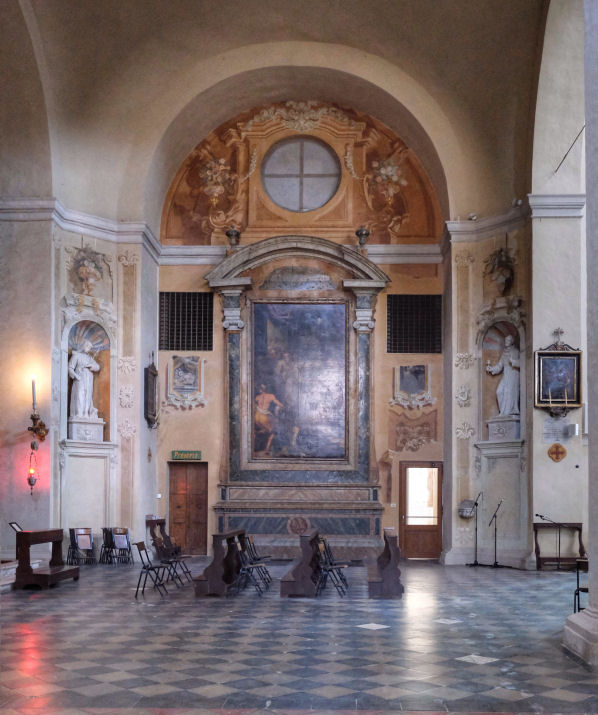
Lots of 17th century art, and 17th-century statues of saints by corner niches, some with
gilding, some polychromed.
The altarpieces are mostly modern devotional statues
behind glass. But the first on the right has a 17th-century
Martyrdom of Saint Matthew by Francesco Costanzo Cattaneo. And
the first left has a
small dark and distant Annunciation also by Cattaneo over the main image of
The Virgin di Pompei by an anonymous 19th-century painter. It
is flanked by gilt-framed displays of relics.
The central left altar, in the cross arm, is dedicated to Saint Rita with an
altarpiece of The Crucifixion with
Donor from the 17th century by G.A. Ghiradoni, with
flanking full-length by the same artist of Saints Francis and
Dominic. The
opposite arm has a matching altar dedicated to Saint Anthony of Padua
The corner to the left of the presbytery (see photo above)
has 18th-century fresco remains on the chapel walls and the end
wall, of the sacristy, by Giuseppe and Pietro Filippi and a painted
altarpiece of The Miracle of San Diego by Domenico Monio, a
Ferrarese artist of the 16th century. Monio had been a cloistered monk at the
Certosa
but the lure of worldly pleasure and a romance caused him to leave
the monastery and become an artist in the studio of his godfather,
Giuseppe Mazzuoli.
century. Monio had been a cloistered monk at the
Certosa
but the lure of worldly pleasure and a romance caused him to leave
the monastery and become an artist in the studio of his godfather,
Giuseppe Mazzuoli.
Lost art in the Pinacoteca
Two panels from a triptych
attributed to Michele Pannonio, a Hungarian artist, showing
Saints Louis and Bernardino from c.1455-63. The central panel
was probably Saint Anthony of Padua.
The Virgin and Child with Saints
Jerome and Francis (the Suxena Altarpiece) painted by Garofalo in 1514, in imitation of Raphael's Madonna di Foligno, is now in
the Pinacoteca. It was commissioned for the Suxhena family chapel here dedicated
to the Immaculate Conception. Vasari described it as "the Virgin in the
air with the Child in her arms, and below some other figures." The Virgin
and Child float in a cloud infested with putti and musical angels and the two donors kneel
in profile between the saints and the
landscape. The dedication of the chapel suggests that the altarpiece's
subject might be the Immaculate Conception. The Virgin having the Child with her
is unusual for this subject but not unprecedented.
A
Saint Jerome by Avanzi.
A Last Supper fresco from the refectory here, with three lunettes of Old
Testament figures, by Garofalo from 1544, removed and acquired by the Pinacoteca
in 1874.
|
|

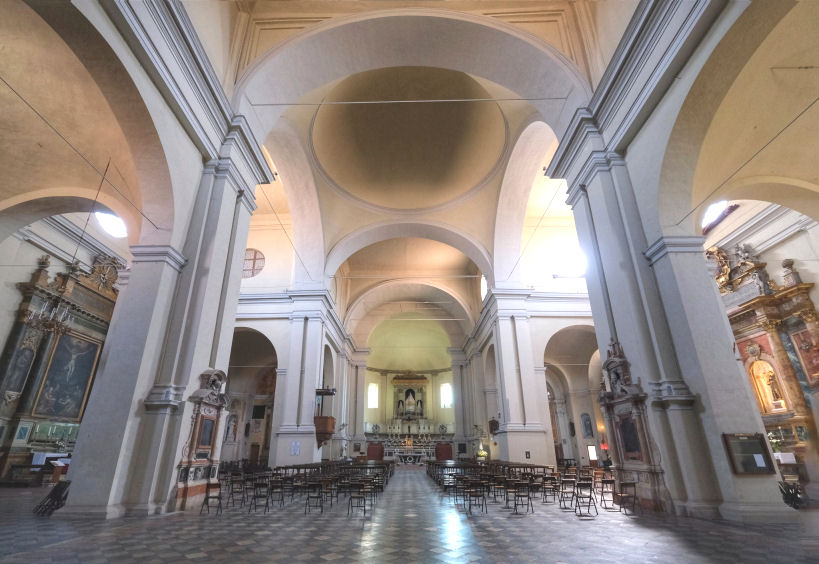 |
|
Santo Stefano
Via Cortevecchia |
|
History
One of Ferrara's oldest
churches, said to have been founded around 960, but certainly built before the 11th
century. It was damaged by the earthquake of 1570
and rebuilt larger with added side aisles. In
1657 it passed to the Congregation of the Oratory of San Filippo Neri,
the Oratorian Fathers,
who restored the interior and provided most of the 17th century art
found here still. They were suppressed in 1796, but the church
remained open.
The current external appearance of the church is the result of the
restorations carried out in 1905 to return its Gothic style.
Bombing in 1944 resulted in much damage (at the time it was
described as destroyed) especially to the ceiling frescoes (1882) by Francesco
Ferrari and rebuilding and reopening followed in 1947, during which
work the frescoes at the base of the campanile (detailed below) were
found. One of the few churches restored and reopened,
in 2016, after the
2012 earthquake
Façade
Has four circular rosaci, with two housing
terracotta busts of Saint Stephen and the Virgin, said to have been
installed during the restoration work of 1824, and one with monogram
of Christ, also known as the logo
of San Bernardino, surrounded by medallions depicting the Apostles. The marble doorcase came from
Biagio Rossetti's
demolished church of
San Silvestro
at the same time.
Interior
visited
Big but not long, minimally decorated, with it's width accommodating a
nave and two wide raised aisles three bays long with large brown
marble altars. These have small windows above them, real on the
left, tromp l'oeil on the right. A pale pastel-panelled high altar,
though in a short presbytery with considerable stonework crumble at
the back (and scaffolding in 2022) . The yellow printed A4 alarm
warnings on all the altars also in fact tell you who the paintings are
by, in smaller type, but apart from an impressive Avanzi Martyrdom
of Saint Lawrence of 1714 (third on the right) you may not need to
know. And near the presbytery are two canvases of scenes from the
life of San Filippo
Neri attributed to Avanzi.
The high altarpiece is The Martyrdom of Saint Stephen framed by
18th-century stuccoes, by Virginio Monti from the 19th century.
In the right aisle the first altar has relics of San Leo and
an altarpiece by Giacomo Parolini from 1689
of" San Leone Magno ,
Sant'Antonio di Padova to San Francesco di Paola The
second altar, but currently in poor
conservation conditions) a canvas
attributed to Antonio Randa in poor condition from the 17th century
of Saint Francis of
Sales approving the Rule of Saint Joan of Chantal.

In the left aisle the first altar
has a 15th-century fresco of
the Madonna delle Grazie which forms the background for a canvas
of Saints John and Paul by Scarsellino. The second
altar has the Virgin placing the Christ Child in the
arms of Santa Caterina Vegri attributed to Ghedini.
Campanile
Built in 1100 it nearly collapsed in 1275, did collapse
in 1339 and was rebuilt
as we see it today, lower and topped more gothicly.
Lost art
The 3rd-century sarcophagus of Annia Faustina, now in the Ferrara
Lapidary Museum, had been repurposed as the high altar here.
A locally-venerated canvas of The Apparition of the
Virgin to St. Philip Neri by Antonio Randa was destroyed in the 1944
bombing.
In 1948 three very fragmentary frescoed lunettes of The Life of Saint
Maurelius, the co-patron-saint of Ferrara, by Vitale da Bologna
from the late 14th century were found in a small chapel at the base of the campanile here. They
were detached, badly, from 1949 and are now in the Casa Romei.
Traces of a starry sky were also found, and some sinopias. |
|
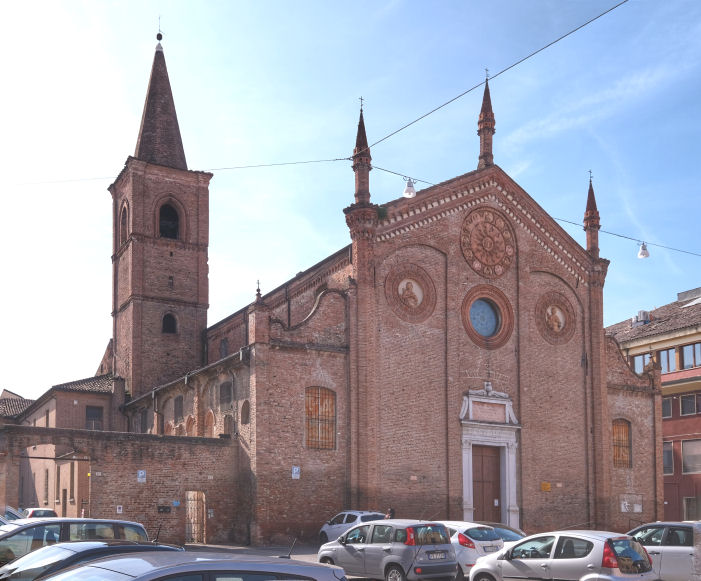
 |

